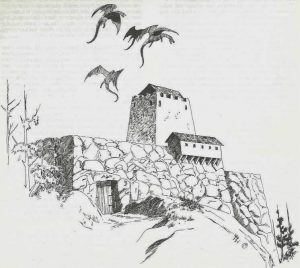For a variety of reasons, many RPG GM’s have less time to design, develop and write original gaming material. Marathon gaming sessions with the same group in high school or college have given way to infrequent gatherings of old friends. The result: time-strapped GM’s have to rely even more on prepared materials and modules. Part of the magic of gaming is the immersive quality of the game setting—artifacts, creatures, cultures and locales all hint at a rich history and a broader world just beyond the players senses. But what happens when the PC’s stray off the modules defined, prepared course? Even a GM with their own extensive world will find themselves in uncharted territories; unprepared for a quirky player decision or random adventure tangent. Even worse are the groups that muddle about without any real direction and seem incapable of making a group decision to move the game forward!!
The original Character Law or Campaign Law alluded to avoiding “channeling players through a path deemed most desirable”, but for a GM with a narrow adventure path provided by a game module or a limited environment hastily sketched out prior to game play, keeping the players within those boundaries is paramount.
Good GM’s can subtly direct their players while maintaining the illusion of a pervasive world; bad GM’s put up roadblocks or punishments as a deterrent which can shatter the gaming experience. Luckily there are two convenient mechanisms in the Shadow World setting to help guide and direct the players while simultaneously connecting them with the larger world: Gods and the Loremasters. Both of these groups create a convenient way to introduce an “adventure hook” as well as a method to redirect a wayward party. Let’s discuss both.
Loremasters. Is there a more established trope than the “wise, mysterious and powerful” guide? Sure, Loremasters may seem a bit generic but they can be fully fleshed-out, flawed and even “in over their heads” NPC’s. However, as part of a larger organization they have real motivations and resources that can give direction and guidance to a party and keep them focused on the adventure goal. Many of the Loremasters described in the SW books are notable individuals, but the organization has younger members still in training that need field experience. It’s more likely that lower level PC’s would encounter one of these apprentice Loremasters. If and when the group grows in experience and power, so to would that younger Loremaster. As the game develops that Loremaster contact can help connect the PC’s to new plots, adventures and tasks; in spycraft terminology the PC’s become a “Field Asset” of the Loremaster! Because the guiding role of the Loremaster can become a heavy hand it’s important to bestow some vulnerabilities on the NPC: Loremasters shouldn’t all be omniscient and all powerful. It might even make sense to have the Loremaster played as a PC with direction, aid and counsel coming down from the Loremaster hierarchy. That provides the GM a more indirect guiding mechanism for the group. Certainly a PC Loremaster would have access to some proprietary information about the game world, but most players can easily download SW books, review the timeline or read the SW novel and know most of the “secrets” of Kulthea! In the end the Loremaster is an established mechanism for guiding the party and keeping them on track.
Gods. One of the often over-looked aspects of playing a Cleric or other religious profession is the compact between the God and the follower. D&D created alignments to enforce player behaviors but game systems without alignments will often encounter the inevitable behavioral drift to the center: self-interest. For Channelers in RM, there are no real game mechanisms outside GM discretion to enforce player behavior that reflects the Deities’ ethos or requirements. However, it is the use of the “God Mechanism” that enables a GM to arbitrarily assign tasks to a follower or group and guide them during an adventure. As the god’s proxy, a follower is meant to further his god’s will and purpose in exchange for miraculous powers (Channeling spells). Too often, Channeling spells are treated the same as Essence or Mentalism—follow the game mechanics, expend PP’s and roll for results. But Channeling should be different than the “agnostic” realms: their use should imply a greater cost or responsibility of the caster to wield such powers. That cost is the crack in the door—the mechanism by which the GM can manage the party. Whether through signs, visitations, dreams or augury, the Priest/Paladin/Druid/Shaman will have a connection or dialogue with their patron as part of their service. The amount of guidance will depend on the involvement of the God; the Orhanian pantheon is relatively aloof but powerful, the Charon pantheon is more “hands-on” but less powerful, while local Gods can be very present but in a limited geography or aspect.
In summation, the Shadow World setting has two already established mechanisms for a GM to guide the party. By filtering direction through either a God or a Loremaster you can keep your group on track, maintain the immersive element of the game and connect the players to the broader world of Kulthea!

